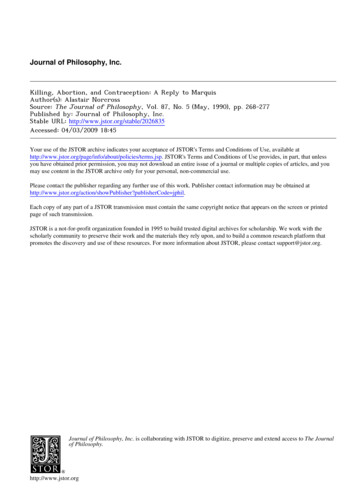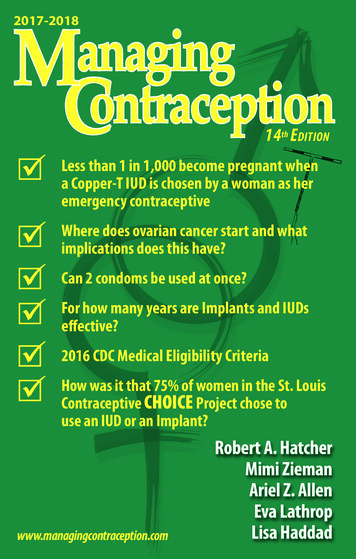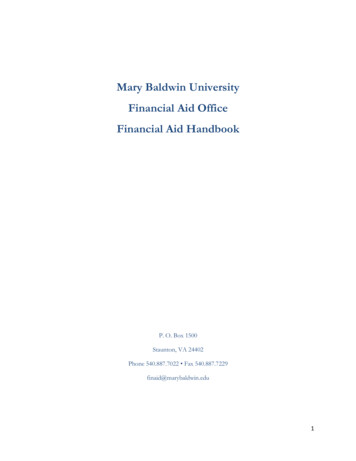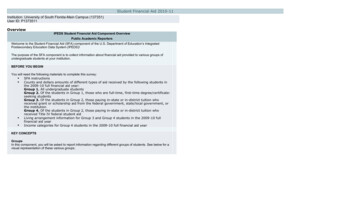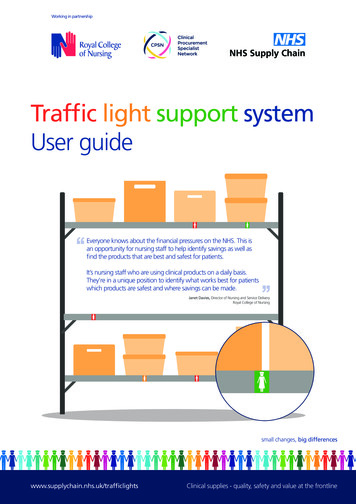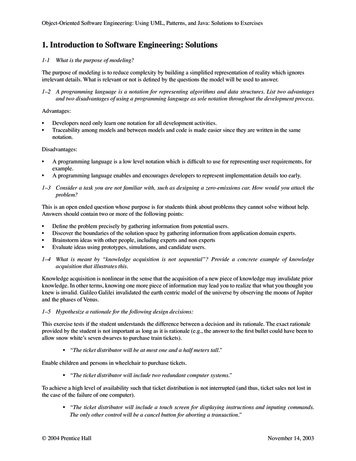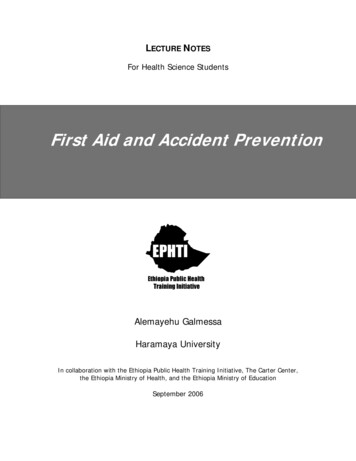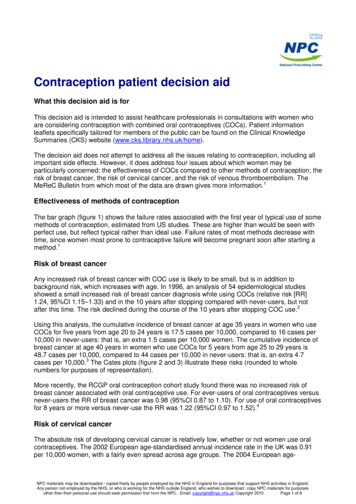
Transcription
Contraception patient decision aidWhat this decision aid is forThis decision aid is intended to assist healthcare professionals in consultations with women whoare considering contraception with combined oral contraceptives (COCs). Patient informationleaflets specifically tailored for members of the public can be found on the Clinical KnowledgeSummaries (CKS) website (www.cks.library.nhs.uk/home).The decision aid does not attempt to address all the issues relating to contraception, including allimportant side effects. However, it does address four issues about which women may beparticularly concerned: the effectiveness of COCs compared to other methods of contraception; therisk of breast cancer, the risk of cervical cancer, and the risk of venous thromboembolism. TheMeReC Bulletin from which most of the data are drawn gives more information.1Effectiveness of methods of contraceptionThe bar graph (figure 1) shows the failure rates associated with the first year of typical use of somemethods of contraception, estimated from US studies. These are higher than would be seen withperfect use, but reflect typical rather than ideal use. Failure rates of most methods decrease withtime, since women most prone to contraceptive failure will become pregnant soon after starting amethod.1Risk of breast cancerAny increased risk of breast cancer with COC use is likely to be small, but is in addition tobackground risk, which increases with age. In 1996, an analysis of 54 epidemiological studiesshowed a small increased risk of breast cancer diagnosis while using COCs (relative risk [RR]1.24, 95%CI 1.15–1.33) and in the 10 years after stopping compared with never-users, but notafter this time. The risk declined during the course of the 10 years after stopping COC use.2Using this analysis, the cumulative incidence of breast cancer at age 35 years in women who useCOCs for five years from age 20 to 24 years is 17.5 cases per 10,000, compared to 16 cases per10,000 in never-users: that is, an extra 1.5 cases per 10,000 women. The cumulative incidence ofbreast cancer at age 40 years in women who use COCs for 5 years from age 25 to 29 years is48.7 cases per 10,000, compared to 44 cases per 10,000 in never-users: that is, an extra 4.7cases per 10,000.3 The Cates plots (figure 2 and 3) illustrate these risks (rounded to wholenumbers for purposes of representation).More recently, the RCGP oral contraception cohort study found there was no increased risk ofbreast cancer associated with oral contraceptive use. For ever-users of oral contraceptives versusnever-users the RR of breast cancer was 0.98 (95%CI 0.87 to 1.10). For use of oral contraceptivesfor 8 years or more versus never-use the RR was 1.22 (95%CI 0.97 to 1.52).4Risk of cervical cancerThe absolute risk of developing cervical cancer is relatively low, whether or not women use oralcontraceptives. The 2002 European age-standardised annual incidence rate in the UK was 0.91per 10,000 women, with a fairly even spread across age groups. The 2004 European age-NPC materials may be downloaded / copied freely by people employed by the NHS in England for purposes that support NHS activities in England.Any person not employed by the NHS, or who is working for the NHS outside England, who wishes to download / copy NPC materials for purposesother than their personal use should seek permission first from the NPC. Email: copyright@npc.nhs.uk Copyright 2010Page 1 of 8
standardised death rate was 0.28 per 10,000 women, and fewer than 6% of these deaths occurredin women aged younger than 35 years.1A re-analysis of data from women with cervical cancer in 2007 found current use of COCs for fiveyears or longer is accompanied by an increased risk of cervical cancer (RR 1·90, 95%CI 1.69–2.13).5 The baseline risk of cervical cancer increases with age, and the number of extra cases inCOC users also increases with age. Risk falls when COCs are stopped and after about 10 years,risk reaches the same level as that for never-users of COCs.From this analysis, the cumulative incidence of cervical cancer at age 50 years in women who useCOCs for five years from age 20 years is 40 cases per 10,000, compared to 38 cases per 10,000in never-users; that is, an extra two cases per 10,000. The cumulative incidence of cervical cancerat age 50 years in women who use COCs for 10 years from age 20 years is 45 cases per 10,000,compared to 38 cases per 10,000 in never-users; that is, an extra seven cases per 10,000.6 TheCates plots (figures 4 and 5) illustrate these risks.More recently, the RCGP oral contraception cohort study found use of oral contraceptives for 8years or more versus never-use was associated with a RR of cervical cancer of 2.73 (95%CI 1.61to 4.61).4Risk of venous thromboembolismAll COCs increase the risk of venous thromboembolism (VTE). The risk associated with COCscontaining the “third-generation” progestogens, desogestrel or gestodene (2.5 per 10,000 womenyears) is greater than that associated with other COCs (1.5 per 10,000 women-years) and withnever-users (0.5 to 1.0 per 10,000 women-years). However, in absolute terms, the risk is still lowand is lower than the risk of VTE in pregnancy (6 per 10,000 women-years).7 The Cates plot (figure6) shows the risk per 10,000 women per 10 years, assuming a constant, cumulative annual risk topermit representation.The VTE risk associated with the use of Yasmin, which contains the “fourth-generation”progestogen, drospirenone, is estimated to lie somewhere between that associated with COCscontaining the “second-generation” progestogen, levonorgestrel and those containing the “thirdgeneration” progestogens, desogestrel or gestodene.8Source of imagesWith the exception of the bar graph, the images have been produced using Dr Chris Cates’s software VisualRx 3.0. Moreinformation can be obtained from the website www.nntonline.net.References1. National Prescribing Centre. Contraception – current issues. MeReC Bulletin; Volume 17, Number 2, November2006. Accessed from: www.npc.co.uk/ebt/merec/therap/contra/merec bulletin vol17 no2 summary.htm2. Collaborative Group on Hormonal factors in Breast Cancer. Breast cancer and hormonal contraceptives:collaborative reanalysis of individual data on 53 297 women with breast cancer and 100 239 women without breastcancer from 54 epidemiological studies. Lancet 1996; 347:1713–27. Accessed S0140-6736(96)90806-5/abstract3. Oral contraceptives and breast cancer. Current Problems in Pharmacovigilance; Volume 24, March 1998. Accessedfrom: tProblemsinPharmacovigilance/CON0074754. Hannaford PC, et al. Cancer risk among users of oral contraceptives: cohort data from the Royal College of GeneralPractitioner's oral contraception study. BMJ 2007;335:651. Accessed 5. International Collaboration of Epidemiological Studies of Cervical Cancer. Cervical cancer and hormonalcontraceptives: collaborative reanalysis of individual data for 16 573 women with cervical cancer and 35 509 womenwithout cervical cancer from 24 epidemiological studies. Lancet 2007;370:1609–21. Accessed S0140-6736(07)61684-5/abstract6. Hormonal contraceptives: cervical cancer – latest evidence. Drug Safety Update Volume; 1, Issue 9, April 2008.Accessed from: fetyUpdate/CON0145057. Combined hormonal contraceptives: venous thromboembolism – update. Drug Safety Update; Volume 1, Issue 9,April 2008. Accessed from: fetyUpdate/CON0145058. Yasmin: update on risk of venous thromboembolism. Drug Safety Update; Volume 3, Issue 9, April rugSafetyUpdate/CON076501NPC materials may be downloaded / copied freely by people employed by the NHS in England for purposes that support NHS activities in England.Any person not employed by the NHS, or who is working for the NHS outside England, who wishes to download / copy NPC materials for purposesother than their personal use should seek permission first from the NPC. Email: copyright@npc.nhs.uk Copyright 2010Page 2 of 8
Figure 1. Effectiveness of contraceptivesEach bar represents 1000 women. The purple portion indicates the likely proportion of women who will become pregnant in the first year of use of themethod. The green portion indicates the likely proportion of women who will not. These are based on typical use of the methods: perfect use woulddecrease the likelihood of contraceptive failure. The first bar shows the likely pregnancy rate in women not using contraception, for comparison.NoneSpermicidesWithdrawalPeriodic abstinenceFemale condom without spermicideMale condom without spermicideProgestogen-only pillCombined pillDepo-Provera injectionFemale sterilisationMale sterilisationMirena0Not enaMale ionCombined pillProgestogenonly pillMale condomwithoutspermicideFemale 50125308080150210250270290850Note: Periodic abstinence methods include calendar methods, etc. Progestogen-only contraceptive pills generally have a higher failure rate thancombined preparations.NPC materials may be downloaded / copied freely by people employed by the NHS in England for purposes that support NHS activities in England. Any person not employed by the NHS, or who is working for the NHS outsideEngland, who wishes to download / copy NPC materials for purposes other than their personal use should seek permission first from the NPC. Email: copyright@npc.nhs.uk Copyright 2010Page 3 of 8
Risk of breast cancerFigure 2. Women aged 20–24 years using COCs for five years: cumulative risk of breast cancer during use and for up to 10years afterwardsConsider 10,000 women aged 20–24 years, using a combined oral contraceptive (COC) for five years (each large block contains 1000 faces). TheCates plot shows the excess risk of having breast cancer diagnosed in the 5 years of use and up to 10 years after stopping COCs (i.e. age 35 years),compared to never-users of that age. Note this relates to women at average risk of breast cancer and it is impossible to know what will happen to anyindividual woman.These 9982 women willnot be diagnosed withbreast cancer, whetheror not they take a COCThese 2 women will bediagnosed with breastcancer as a result oftaking a COCThese 16 women will bediagnosed with breastcancer whether or not theytake a COCNPC materials may be downloaded / copied freely by people employed by the NHS in England for purposes that support NHS activities in England. Any person not employed by the NHS, or who is working for the NHS outsideEngland, who wishes to download / copy NPC materials for purposes other than their personal use should seek permission first from the NPC. Email: copyright@npc.nhs.uk Copyright 2010Page 4 of 8
Figure 3. Women aged 24–29 years using COCs for five years: cumulative risk of breast cancer during use and for up to 10years afterwardsConsider 10,000 women aged 24–29 years, using a combined oral contraceptive (COC) for five years (each large block contains 1000 faces). TheCates plot shows the excess risk of having breast cancer diagnosed in the 5 years of use and up to 10 years after stopping COCs (i.e. age 40 years,compared to never-users of that age. Note this relates to women at average risk of breast cancer and it is impossible to know what will happen to anyindividual woman.These 9951 women willnot be diagnosed withbreast cancer, whetheror not they take a COCThese 5 women will bediagnosed with breastcancer as a result oftaking a COCThese 44 women will bediagnosed with breastcancer whether or not theytake a COCNPC materials may be downloaded / copied freely by people employed by the NHS in England for purposes that support NHS activities in England. Any person not employed by the NHS, or who is working for the NHS outsideEngland, who wishes to download / copy NPC materials for purposes other than their personal use should seek permission first from the NPC. Email: copyright@npc.nhs.uk Copyright 2010Page 5 of 8
Risk of cervical cancerFigure 4. Women using COCs for 5 years from age 20 years: cumulative risk of cervical cancer at age 50 yearsConsider 10,000 women using a combined oral contraceptive (COC) for 5 years from age 20 years (each large block contains 1000 faces). The Catesplot shows the excess risk of having cervical cancer at age 50 years, compared to never-users. Note this relates to women at average risk of cervicalcancer and it is impossible to know what will happen to any individual woman.These 9960 women willnot be diagnosed withcervical cancer, whetheror not they take a COCThese 2 women will bediagnosed with cervicalcancer as a result oftaking a COCThese 38 women will bediagnosed with cervicalcancer whether or not theytake a COCNPC materials may be downloaded / copied freely by people employed by the NHS in England for purposes that support NHS activities in England. Any person not employed by the NHS, or who is working for the NHS outsideEngland, who wishes to download / copy NPC materials for purposes other than their personal use should seek permission first from the NPC. Email: copyright@npc.nhs.uk Copyright 2010Page 6 of 8
Figure 5. Women using COCs for 10 years from age 20 years: cumulative risk of cervical cancer at age 50 yearsConsider 10,000 women using a combined oral contraceptive (COC) for 10 years from age 20 years (each large block contains 1000 faces). TheCates plot shows the excess risk of having cervical cancer at age 50 years, compared to never-users. Note this relates to women at average risk ofcervical cancer and it is impossible to know what will happen to any individual woman.These 9955 women willnot be diagnosed withcervical cancer, whetheror not they take a COCThese 7 women will bediagnosed with cervicalcancer as a result oftaking a COCThese 38 women will bediagnosed with cervicalcancer whether or not theytake a COCNPC materials may be downloaded / copied freely by people employed by the NHS in England for purposes that support NHS activities in England. Any person not employed by the NHS, or who is working for the NHS outsideEngland, who wishes to download / copy NPC materials for purposes other than their personal use should seek permission first from the NPC. Email: copyright@npc.nhs.uk Copyright 2010Page 7 of 8
Risk of venous thromboembolism (VTE)Figure 6. Women any age, using COCs for 10 years: risk of VTE over 10 yearsConsider 10,000 women using third generation progestogen containing combined oral contraceptives (COC), i.e. those containing desogestrel orgestodene (each large block contains 1000 faces). The Cates plot shows the excess risk of developing VTE associated with a COC containingdesogestrel or gestodene, compared to women using a COC containing the second generation progestogen, levonorgestrel, over 10 years assuminga constant rate for purposes of illustration. The annual risk is one extra case in 10,000 women per year compared to one or two cases with otherCOCs, 0.5 to one case per 10,000 women-years in non-users and six cases per 10,000 women-years in pregnancy. Note this relates to women ataverage risk of VTE and it is impossible to know what will happen to any individual woman.These 9975 women willnot develop VTE, whetheror not they take a COC ofeither typeThese 10 women willdevelop VTE as a resultof taking a COCcontaining desogestrelor gestodeneThese 15 women willdevelop VTE whether theytake a COC containingdesogestrel or gestodene,or a COC containinglevonorgestrel. 5 to 10 ofthem would develop VTE ifthey did not take either typeof COCNPC materials may be downloaded / copied freely by people employed by the NHS in England for purposes that support NHS activities in England. Any person not employed by the NHS, or who is working for the NHS outsideEngland, who wishes to download / copy NPC materials for purposes other than their personal use should seek permission first from the NPC. Email: copyright@npc.nhs.uk Copyright 2010Page 8 of 8
Depo-Provera injection Combined pill Progestogen-only pill Male condom without spermicide Female condom without spermicide Periodic abstinence Withdrawal Spermicides None. Note: Periodic abstinence methods include calendar methods, etc. Progestogen-only contraceptive pills generally have a higher failure rate than combined preparations.

